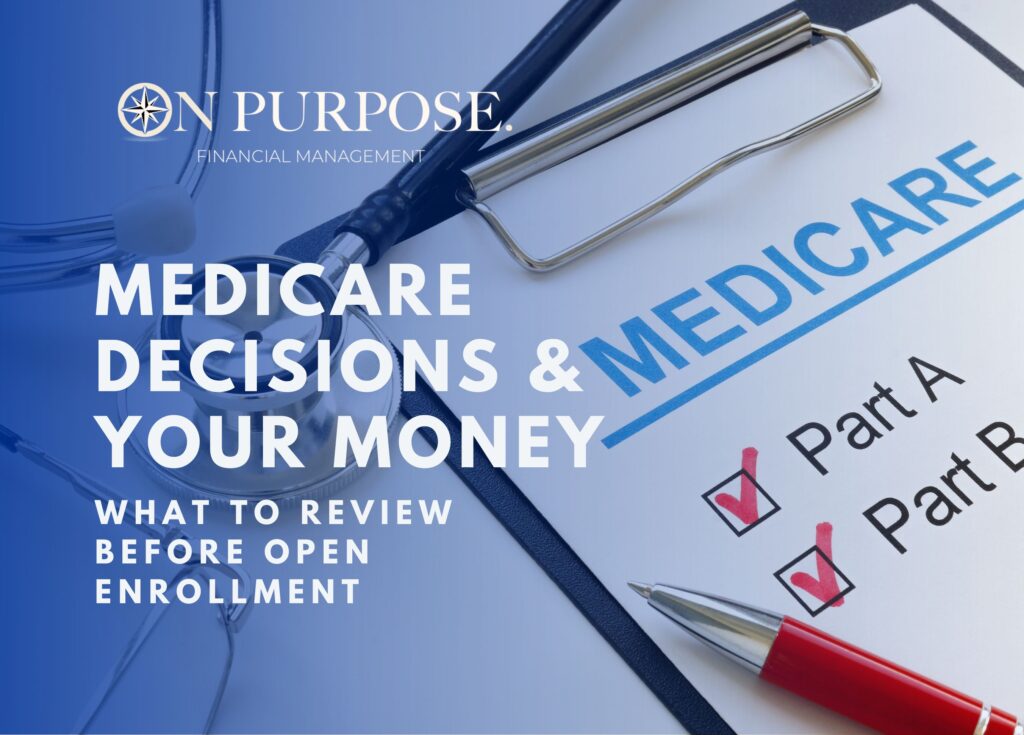Medicare Decisions & Your Money: What to Review Before Open Enrollment

By On Purpose Financial
Expert insight contributed by Chris J. Todd, Benefits Consultant, Health Plans of Georgia
When you left the corporate world, you didn’t leave open enrollment behind, you just graduated to a version with higher stakes. Each fall, Medicare enrollees face a wave of mailers, phone calls, and TV ads all promising “more benefits for less.” The result? Decision fatigue. And costly mistakes.
“Most people are sold something; they’re not advised. Education keeps you in charge.” – Chris J. Todd
The two roads in Medicare (and why the choice matters)
Think about Medicare as two distinct roads:
- Original Medicare (A & B)
- A = Hospitalization (you paid in during your working years).
- B = Medical (monthly premium, income-based).
- With Original Medicare, you can add:
- a Medigap (Supplement) to cover most/all of the 20% not paid by A & B, and
- a standalone Part D drug plan.
- Network: If a provider accepts Medicare, you’re in. No network hoops.
- Medicare Advantage (Part C)
- An insurance company packages A, B, (a version of) Supplement, and D into one plan, often at lower monthly cost.
- Trade-off: The insurer, not you and your doctor, now has more control over coverage and approvals. Plans are network-based and can limit options.
Chris’s take is blunt: Advantage plans can be the right fit for tight budgets, but they can also be a trap if your health changes later. After the first-year “trial right,” moving back to Original Medicare often requires medical underwriting. If you’ve had a new diagnosis, you may not qualify for a Medigap plan, precisely when you want broader coverage.
Why this is a financial planning decision
Medicare is healthcare, yes—but it’s also cash flow, risk management, and tax planning:
- Cash flow:
Original Medicare + Medigap + Part D can run a few hundred dollars per month; Advantage often advertises lower premiums. But lower premiums may mean higher out-of-pocket at the worst time. - Coverage risk:
Narrow networks, prior authorizations, or limited rehab options can translate into delays, denials, or higher bills. This is a real risk to both health and wealth. - Income-related surcharges (IRMAA):
Part B (and Part D) premiums are tiered by income using your tax return from two years ago. A one-time spike (selling a business, large Roth conversion, big property gain, taking extra from retirement accounts for a roof or car) can bump you into a higher tier for a year, adding hundreds per month, per person.
“A client’s Part B went from roughly $200 to over $700 per month after a practice sale, for each spouse. The trigger was two years prior.” – Chris J. Todd
Where we help: At On Purpose Financial, we map retirement income across years, not just this year, to avoid or at least attempt to understand IRMAA surprises and keep your healthcare and tax planning working together.
What to review before you renew
Use this checklist each fall (especially starting October 15, when changes for Advantage and drug plans open):
- Health changes: New diagnoses, new specialists, or expected procedures?
- Prescriptions: Have any meds changed that affect your Part D or Advantage drug formulary?
- Provider access: Do your doctors/hospitals remain in-network (if on Advantage)?
- Travel plans: Will you need care while out of state or abroad? (Consider travel medical.)
- Income outlook: Any big, one-off income events two years ago, or coming up now?
A smarter process (advisor + specialist)
- Talk with your financial advisor first about income timing, Roth conversions, or asset sales and how they could affect IRMAA.
- Consult a licensed Medicare specialist for plan mechanics and options.
“Educate yourself, and work with an advisor, not a salesperson.” – Chris J. Todd
Top 5 Questions to Ask Before You Change Plans
- What would my worst-case out-of-pocket look like under this plan?
- Are my doctors and hospitals in-network (if Advantage)?
- How are my specific prescriptions covered next year?
- If my health changes, can I switch back to Original Medicare + Medigap?
- Will my two-year-lookback income trigger IRMAA next year?
Disclaimer: This article is for educational purposes only and is not tax, legal, or Medicare plan advice. Consult a licensed Medicare professional and your tax advisor for your situation. Chris Todd of Health Plans of Georgia is an independent third party. Material Prepared by Tic Tac Toe Marketing, an independent third party. Any opinions are those of the author, are subject to change without notice and are not necessarily those of Raymond James. This material is being provided for information purposes only and does not purport to be a complete description of the securities, markets, or developments referred to in this material and does not constitute a recommendation. The information has been obtained from sources considered to be reliable, but we do not guarantee that the foregoing material is accurate or complete. Investing involves risk and investors may incur a profit or a loss regardless of strategy selected. Neither Raymond James Financial Services nor any Raymond James Financial Advisor renders advice on tax or legal issues, these matters should be discussed with the appropriate professional.
